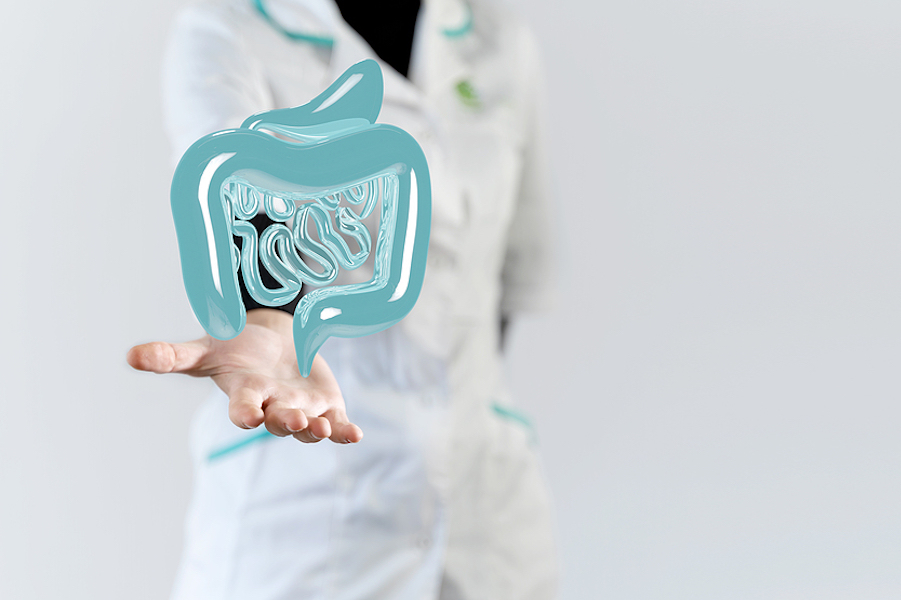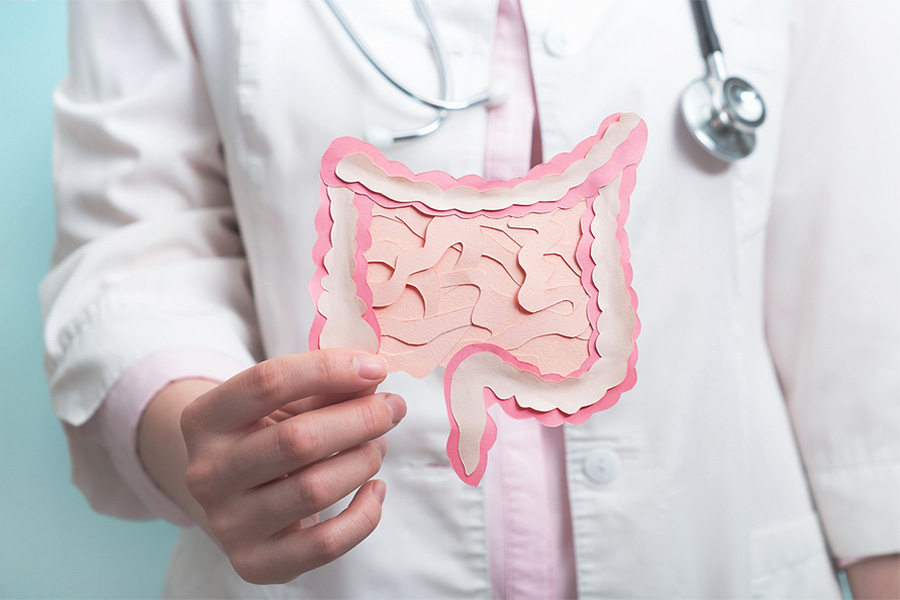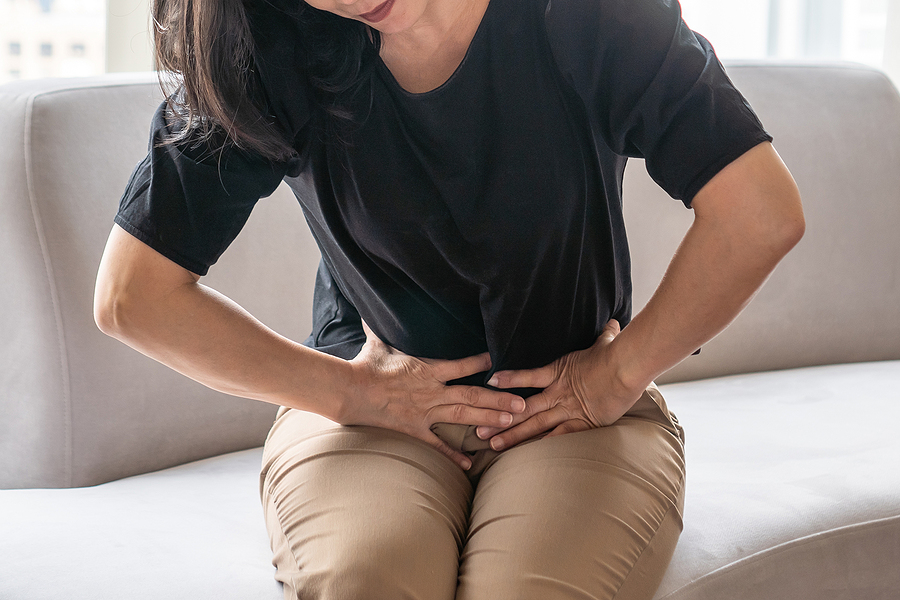When I started my practice in the early 1980s, I was amazed at the number of women who suffered from constipation, diarrhea, increased gas, bloating after eating, fatigue and the many other symptoms of gastrointestinal distress.
It wasn’t long before I realized this was a women’s health issue. Research indicates that gastrointestinal distress is twice as common in women as in men, that women have a greater incidence of complicating factors (like fibromyalgia, migraine, and heartburn) and that for some women, symptoms follow their menstrual cycle.
In the past I often referred patients to gastroenterologists when they came to me with these symptoms. Frequently they came back to me with the diagnosis of Irritable Bowel Syndrome (IBS), and the recommendation that they should make dietary changes, increase fiber in their diet and use Metamucil. Too often these changes brought them no relief. I was aware at that time that stress could play a part in their discomfort, and made suggestions accordingly. But this also did not seem to be very effective. This kind of distress is considered a non-serious “functional condition” (meaning not a disease) in the professional medical community. But as a veteran of visits to third-world countries, I knew from personal experience how uncomfortable and frustrating these symptoms can be.
After years of reading and professional learning, I now believe that IBS is just the beginning of the story, not the conclusion. I think IBS is being used by doctors as a catch-all diagnosis for a complicated host of symptoms that need to be explored in depth before the root cause (such as yeast, parasites or food sensitivities) can be identified and treated. Because of my own experience with GI distress, I now test for intestinal parasites in every woman who comes into the clinic with a diagnosis of IBS or similar symptoms. You may be surprised to learn that 40% of these women prove to have intestinal parasites — even though many have never left the United States.
Let’s talk about how these symptoms arise and what you can do about them.
An unwelcome souvenir
In the mid 1980s I went to Mexico and ended up with what is known as “Montezuma’s Revenge.” I returned to the U.S. and realized I had all the symptoms that my patients had been complaining about. So I did a stool test which was sent to the hospital. I was surprised when the test indicated nothing abnormal.
Being the persistent person that I am, I did not stop there, but began to explore within the alternative medical community what options were available. I found a chiropractor who recommended a lab in Arizona. Sure enough, this stool test came back indicating intestinal parasites. She then effectively treated me and also recommended staying away from particular foods to which I had become sensitive. My symptoms disappeared. So began my real awakening to the alternatives for women who suffer from gastrointestinal symptoms that can not be explained as irritable bowel syndrome or simply secondary symptoms of anxiety.
Role of the gastrointestinal tract
The major function of the gastrointestinal system is to break down food and establish a means by which the nutrients can be absorbed in the body. Nutrients that are liberated by this process allow the body to grow, heal and function on a day-to-day basis. In the mouth, the teeth break up the food and mix it with saliva. Salivary enzymes initiate the breakdown of food into usable forms, particularly with fat and starch digestion.
The stomach mechanically churns food, breaks up and emulsifies fat and exposes the molecules to multiple enzymes such as hydrochloric acid and pancreatic juices. The surface area of the gastrointestinal tract is approximately the size of a football field and filled with friendly and unfriendly bacteria. Needless to say, a number of factors may go awry. Because the intestinal tract plays a key part in nutrient absorption, any problem there can affect the function of the entire body and our overall health.
Disordered intestinal ecology that actually causes illness is described by Dr. Leo Galland as dysbiosis. Organisms that are not usually overgrown in the intestines, such as unfriendly bacteria, yeast and protozoa, actually induce disease by altering nutrition patterns in the body. Dr. Galland and a number of others believe, as I do, that optimal health requires that the intestinal flora maintain a healthy balance between the more than 400 organisms that usually reside there and not an overgrowth of any particular one.
Signs and symptoms of malabsorption, intestinal parasites or low gastric acid
- Bloating, belching, burning, flatulence after meals
- A sense of fullness after eating
- Indigestion, diarrhea, constipation
- Systemic reactions after eating
- Nausea after taking supplements
- Rectal itching
- Weak or cracked fingernails
- Dilated capillaries in the cheeks and nose in the non-alcoholic
- Post-adolescent acne or other skin irritations such as rosacea
- Iron deficiency
- Chronic intestinal infections, parasites, yeast, bacteria
- Undigested food in the stool
- Greasy stools
- Easy bruisability
- Fatigue
- Amenorrhea (absence of menstruation)
- Chronic yeast infections
- Chronic vaginitis (vaginal irritation)
Some authors have speculated that other symptoms, such as impotence, loss of libido, infertility, muscle atrophy, cramps and joint pain, are also linked to malabsorption. A fair amount of research supports this connection.
The intestinal environment
Do many people really have intestinal parasites? How do they infect the intestinal flora? When I first began working with women who had issues of bloating and gas, I never anticipated I would see as many women with intestinal parasites as I have. My expectation was that intestinal parasites only occurred in third world countries. We know from a number of studies that in such countries, intestinal parasites affect up to 99% of the population. The problem in the United States is obviously much less, but it is growing.
In the U.S., because we have grown up with many sanitary conveniences, we assume that intestinal parasites are only encountered in other parts of the world. As one expert has written “…the United States citizen can acquire amoebas, Giardia, pinworms and other parasites, for example, without so much as a passport application.” More and more produce is being imported from third world countries that do not have the same regulations for growing mediums and fertilizer sources. Salad bars and the increase in the number of meals eaten out worsen your odds. Ironically, we often see parasite infections in “juicers” – people who have wonderful dietary habits. Other factors include the ease and frequency of worldwide travel, increased immigration, and contaminated water supplies. Although this has not yet been documented, we believe environmental pollution also plays a role by suppressing the immune system on a number of levels.
What are the major causes of intestinal dysbiosis?
- Stress
- Diets that are poor or imbalanced (largely comprised of carbohydrates, fat, or animal products) and lacking nutritional supplementation
- Food allergies or sensitivities
- Frequent antibiotic or drug therapy, such as Prednisone
- An immune system that is suppressed; this can occur for a number of reasons, including emotional distress
- Intestinal infections
- Parasite infestation
- Inflammation
It’s important to emphasize that if our intestinal tract were balanced, infestation would rarely occur — even if we were exposed to parasites — as the immune system would work naturally to keep the parasite population under control. However, eating spoiled or heavily infested food will make even a healthy system sick.
Like your hormones, the flora in your digestive system are easily prone to upset and disruption by external sources. This is where stress, self-criticism and anxiety come into play by changing the pH level (the acid/alkaline balance) in your intestines. The intestinal tract is noticeably one of the first areas of the body to react to fear or personal stress (think of the nausea and/or loose-bowel feeling that can accompany stage fright). In a balanced system, once the stress is reduced, the pH balance straightens out and symptoms disappear. In a weakened system, such as one under unrelenting stress, the intestines stay irritated and contribute to chronic discomfort.
The link between dysbiosis and heartburn/acid reflux
Most of us think of IBS in relation to our intestines. It’s useful to know that many women with a diagnosis of IBS also complain of symptoms in their upper GI tract: heartburn/acid reflux, nausea, and stomach pain. These symptoms are related to the rate at which the stomach empties. If the gastric environment is out of balance, the stomach tries to squeeze its partially digested contents out from both ends as quickly as possible. This leads to a burning sensation that many of us self-medicate with antacids. In my experience, acid reflux and chronic heartburn can actually be the result of too little acid in the stomach — not too much.
Use of antacids will initially lend some relief, but overuse will only end up aggravating the underlying condition. In addition, antacid use can lower the acidity of the stomach to such a degree that it loses its ability to protect us from bacterial infection. It is now widely recognized that bacterial infection can cause ulcers. For more information, read our article, “The Link Between IBS, Acid Reflux and Antacids.”
Of course, if you are currently taking prescription medication for heartburn like Nexium or Prilosec, do not stop taking it except with the advice of your primary care provider. If you’d like to seek an alternative (of which there are many), look for an alternative practitioner in your area.
Why are women more prone than men to GI distress?
In the United States and other Western cultures, women are 2-3 times more likely to seek out medical help for digestive disorders than men. There is still a lot of research to be done on this topic, but preliminary data suggest that ovarian hormones (estrogen/progesterone) play a decisive role in digestion.
Most of us are familiar with the bloated feeling that occurs around our period. Some of this feeling may be attributed to how quickly our stomach and intestines empty in the last two weeks of a cycle compared to the first two weeks. Research points to the fact that transit time slows significantly during the last two weeks of a woman’s monthly cycle (luteal phase) with a marked rise in digestive complaints right before a period starts. It also seems clear that post-menopausal women see a similar delay. It would appear that a decline in ovarian hormones is strongly linked to a rise in symptoms of GI distress.
How does one detect digestive problems?
In our experience, most labs do not provide an effective stool analysis. We have had excellent results over many years using two different tests done by a select group of labs. The first is the comprehensive digestive stool analysis (or CDSA) that evaluates the stool for malabsorption, yeast, parasites, pH imbalance, and bacterial overgrowth. The second is a comprehensive parasitology test (CP x 2) with a purge, which is a more detailed test for intestinal parasites. While not routine procedure at the hospital or doctor’s office, these tests are crucial for identifying the root cause of GI distress and should be undertaken even if a standard stool test has revealed no abnormalities.
You may contact these labs directly or request that your healthcare provider do so to order these tests on your behalf:
Great Smokies Diagnostic Labs: 1-800-522-4762
Diagnos-Techs: 1-800-878-3787
Doctor’s Data: 1-800-323-2784
Parasitology Center: 1-480-767-2522
The first three labs offer both tests in one procedure; the last lab only offers the CP x 2 for parasites. For the most difficult cases, I prefer to do the comprehensive digestive stool analysis (CDSA) at one of the first three labs and the CP x 2 at the Parasitology Center.
What is the treatment for digestive problems?
Any woman suffering from gastrointestinal upset, including a chronic sense of fullness or bloating, should first see their healthcare practitioner. Most of the time these symptoms are easily treatable, but on occasion they may indicate a more serious condition.
My experience in working with women with dysbiosis, chronic candidiasis or parasite infection is that tests need to be done to evaluate the flora of the intestines and to establish if there is systemic yeast, parasites or food sensitivities (the latter often accompany digestive problems). With these test results as a guide, dietary changes are recommended and emotional issues, such as depression or stress, are addressed in conjunction with a regime of nutritional supplements.
Once the results of the tests are back, it is easily determined what nutritional changes need to take place, whether a blood test should be done for food sensitivities, and what particular supplements need to be added to the dietary regime. If we suspect food sensitivity — usually dairy, wheat, or sugar — we recommend eliminating the potential allergen from a patient’s diet for a week and then reintroducing it for a day. Most of the time it is immediately obvious that a sensitivity is present. Supplementing nutrition with a pharmaceutical-grade multivitamin is critical in restoring health to the digestive tract. Especially important is the addition of essential fatty acids that contribute to reducing inflammation in the intestines.
A daily dose of probiotics, such as acidolpholus and bifidobacteria, is helpful in maintaining the right ratio of bacteria in the intestines. This is especially important if you are taking antibiotics, as these drugs destroy both friendly and unfriendly bacteria indiscriminately. Be sure to find a probiotic with at least 10 billion live organisms per dose. Marcellepick.com has a specially formulated probiotic that you can order here.
One woman’s story
Sarah is a 45-year-old with a five-plus year history of gastrointestinal complaints which consist of alternating constipation, diarrhea, and sensitivity to certain foods, chronic bloating, increased flatulence, possible environmental allergies, increased fatigue and upper respiratory complaints.
Of note, Sarah was in her third marriage, this time to a man who was probably an alcoholic, and was living in a house (completely furnished by his mother) that he had prior to their marriage. Sarah began doing recovery work years ago. She continues to look at how she can establish boundaries for herself in this home with her husband and is also looking at whether this is the best place for her to be.
At the same time, Sarah came to us and chose to have a food allergy panel done; we also did a CDSA and a CP X 2 with a purge. The tests indicated yeast, an overgrowth of bacteria, imbalanced intestinal flora and multiple food sensitivities. She was placed on a number of supplements, asked to avoid the food allergens, and placed on a yeast-free diet.
Soon Sarah felt better than she had ever felt in her life. She had no constipation, diarrhea, abdominal bloating or pain, her energy level was better than she could remember and she describes feeling at least twenty years younger. She is now able to set boundaries in her life. She has made changes in her marriage and home environment and is beginning to do career counseling to look at what she wants to do with her life. As Sarah proves, when you feel better, it’s easier to take the steps needed to improve your life.
Sarah explained on her last visit that she finally feels as though she has reached a sense of balance in her life. She realizes now that she has done her inner work by looking at the emotional issues that kept her “stuck” and has done the outer pieces which included getting the physical dimensions in order. She feels now that the inner and outer parts of herself are in alignment. I anticipate no further problems with dysbiosis.







